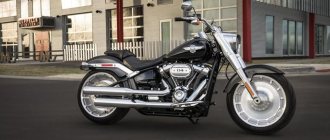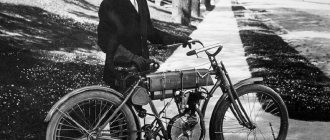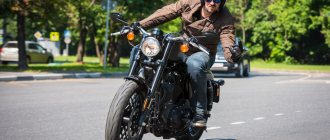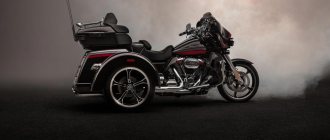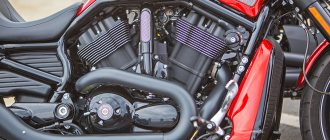ShovelHead [ ]
Shovelhead. Produced from 1966 to 1984, it replaced the PanHead and was subsequently replaced by the Evo. From 1966 to 1978 the engine capacity was 73.66″ 1200 cm3, the 1978-1984 modification had a volume of 82″ or 1340 cm3. Early ShowelHeads are very similar to PanHeads because they are based on a similar base. Since 1969, the similarity has been lost. The most unreliable engine. Black streak - it was at this time that Harley was under the control of the AMA. It was at this time that reliability problems began. It is from this time that Harley cannot “wash off” the stereotypes - it is unreliable, breaks down, pisses on oil, etc.
Due to what features does the Yamaha XV950 outperform its American prototype?
Despite the “Made in Japan” sign attached to the frame, this motorcycle is built according to classic American canons. Moreover, you don’t need to have limitless imagination to discern in it the features of the well-known Harley model. And here’s what’s curious: the imitation turned out almost better than the original.
Cars on Moskvoretskaya embankment were stuck in a traffic jam. Having carefully slipped along the aisle to the intersection, I felt for neutral with my left foot and prepared to wait for the green light. A Nissan Teana stopped to my right; the driver was carefully inspecting my motorcycle. Finally, the comrade gathered his courage and lowered the window:
— XV950. Aka Bolt.
- Beautiful! Probably remade?
- No, it’s completely drained.
Then they gave the green light, and I rushed forward into the arms of a new traffic jam, now clearly understanding where to start the story about the Yamaha XV950.
I think if there was no brand name on the gas tank, identifying the motorcycle would be much more difficult. Air-cooled V-Twin, belt drive, relatively modest dimensions, alloy wheels, sparse decor - all this is very reminiscent of the Harley-Davidson Sportster Iron 883. But we have a Yamaha.
In Russia, the XV950 is considered a new model - it appeared in dealers only this spring. However, on the other side of the Atlantic, this motorcycle has been sold since last year under the name Star Bolt - in the American market, Yamaha cruisers have been developed into a separate brand: Star Motorcycles.
Why bobber? The XV950 is really noticeably different from classic cruisers, which many incorrectly call choppers. After all, for a motorcycle to be considered a chopper, it must have a disconnected fork and a large wheel placed far forward, as well as a high handlebar.
Yamaha does not have all this goodness. The steering wheel is standard, the fork angle (also called “rake”) is within normal limits, and the wheelbase is quite short. Another thing is the almost complete absence of chromium. The appearance is extremely laconic, nothing superfluous. Perhaps the best way to describe the style of the XV950 is “beaver” - this is the name given to motorcycles from which “unnecessary” parts have been removed to reduce weight. Once upon a time, this operation had a purely practical meaning: by ridding the bike of lighting equipment, instruments, a passenger saddle and wings, it was possible to make it go faster. For what? To increase the chances of winning in amateur dirt track racing, which was very popular in pre-war America.
Through the heavily tinted glass of the only device in sunny weather, the burning warning lamps are difficult to see
Photo: Dmitry Lebedev, Kommersant
But for some time now, the fight against excesses has turned into flirting with style; fortunately, no one has demanded sporting feats from modern bobbers for a long time. The main thing is that it is beautiful. Practicality for this type of equipment is the tenth thing, but not the last: you can’t appear on public roads without lighting devices, and it’s not much fun to ride with the wings removed. In general, it’s like this: in our realities, a bobber should be a full-fledged motorcycle.
I must say, the question regarding alterations was also appropriate. The Bolt itself looks quite old-school, but some of the details seem acquired rather than innate. This includes an LED light mounted on the rear fender, combining a side light with a brake light; and the echoing “tin can” of the dashboard with a digital speedometer and warning lights; and petal brake discs - all these decorations can be found in a tuning catalog rather than in the basic configuration.
But the Japanese also made sure that the owner of the XV950 had something to do after the purchase besides actually riding the new motorcycle. On the American website, the list of branded accessories includes more than 50 items - from all kinds of decor and a passenger seat (in the US Bolt is single-seater by default) to spoked wheels. In addition, in America there is a whole customization industry that produces a myriad of components that make it possible to turn a standard bike into a unique one. Although, for what it’s worth, Yamaha is far from Harley in this sense.
BlockHead - Evo [ ]
Evolution. Produced from 1983 to 1999, it replaced the ShowelHead and was subsequently replaced by the TwinCam. Engine capacity 80″ or 1340 cm3. From a distance it looks very similar to TwinCam. You can distinguish them by the “Timing Cover” on the right, the Evo has two rivets vertically, and the cylinder head covers – the Evo has THREE parts. For the first time, fuel injection (injector) was used on this engine in 1996.
There are no longer any problems with reliability, the company has returned back to the Harley-Davidson family, the quality is at the same level.
Harley-Davidson
From left to right: William A. Davidson, Walter Davidson Sr., Arthur Davidson and William S. Harley
In 1901, 20-year-old William S. Harley developed plans for a small engine with a displacement of 7.07 cubic inches (116 cc) and four-inch (102 mm) flywheels[7][8], intended for use in a stock pedal-cycle bicycle frame. Over the next two years, he and his childhood friend Arthur Davidson worked on his motorcycle using a machine shop on Milwaukee's north side at the home of their friend Henry Chalk. It was completed in 1903 with the help of Arthur's brother Walter Davidson. After testing his power cycle, Harley and the Davidson brothers found that he could not climb the hills around Milwaukee without pedal assistance, and wrote off their first motorcycle as a valuable learning experiment. [9]
The three began work on a new and improved machine with a 24.74 cubic inch (405 cc) engine with 9.75 inch (24.8 cm) flywheels and a weight of 28 pounds (13 kg). Its improved loop-frame design was similar to the 1903 Milwaukee Merkel motorcycle designed by Joseph Merkel, later of Flying Merkel fame. The larger engine and loop frame design took it out of the motorcycle category and marked the way for future motorcycle designs. They also received help with their big engine from outboard motor pioneer Ole Evinrude, who was then building gas engines of his own design for use in automobiles on Lake Street in Milwaukee.
Prototype
The prototype of the new loop-frame Harley-Davidson was assembled in a 10 ft × 15 ft (3.0 × 4.6 m) shed in the Davidson family's backyard. [10] [11] Most of the major parts, however, were made elsewhere, including some that were probably made in the West Milwaukee railroad shops, where older brother William A. Davidson was a tool shop foreman. This prototype machine was operational by September 8, 1904, when it competed in the Milwaukee Motorcycle Race held at State Fair Park. Edward Hildebrand rode it and finished fourth in the race. [10]
In January 1905, the company placed small advertisements in the magazine
Automobile
and Cycle Trade Journal,
offering "clean" Harley-Davidson engines for the DIY trade. By April they were producing motorcycles in very limited quantities. That same year, Harley-Davidson dealer Carl H. Lang of Chicago sold three of the five motorcycles built in Davidson's backyard shed. Years later, the company moved the original barn to the Juneau Avenue factory, where it stood for decades as a tribute.
In 1906, Harley and the Davidson brothers built their first factory on Chestnut Street (later Juneau Avenue),[12] where Harley-Davidson is now headquartered. The first plant on Juneau Avenue was a one-story wooden structure measuring 40 ft × 60 ft (12 m × 18 m). The company produced about 50 motorcycles that year.
Model 1907.
Harley-Davidson 1000 cc HT 1916
William S. Harley graduated from the University of Wisconsin-Madison in 1907 with a degree in mechanical engineering. That same year they expanded the factory with a second floor and later cladding and adding pale yellow ("cream") Milwaukee brick. With the advent of new facilities, production increased to 150 motorcycles in 1907. The company was officially registered in September of the same year. Around this time, they also began selling their motorcycles to police departments, and the market has been important to them ever since. [13] In 1907, William A. Davidson left his job as a toolmaker for the Milwaukee Road Railroad and joined the Motor Company.
In 1905 and 1906, all single-cylinder models were produced with 26.84 cubic inch (440 cc) engines. In February 1907, they presented a prototype model at the Chicago Auto Show, powered by a 45-degree V-Twin engine. Very few V-Twin models were built between 1907 and 1910. These first V-Twins displaced 53.68 cubic inches (880 cc) and produced about 7 horsepower (5.2 kW). This gave about twice the power of the first singles and a top speed of about 60 mph (100 km/h). Production increased from 450 motorcycles in 1908 to 1,149 cars in 1909 [14].
Harley-Davidson running in 1911.
In 1911, the company introduced an improved V-Twin model with a displacement of 49.48 cubic inches (811 cc) and mechanically controlled intake valves, as opposed to the "automatic" intake valves used on earlier V-twins, which opened engine vacuum. It was smaller than the previous twins, but provided better performance. After 1913, most motorcycles produced by Harley-Davidson were V-Twin models.
In 1912, Harley-Davidson introduced its patented Ful-Floteing seat, which was suspended by a coil spring inside the seat tube. [15] Spring tension could be adjusted to suit rider weight, and over 3 inches (76 mm) of travel was available. [16] Harley-Davidson used this type of seat until 1958. [17]
By 1913, the yellow brick plant was demolished and a new five-story building was built on the site, which occupied two blocks along Juneau Avenue and around the corner at 38th Street. Despite the competition, Harley-Davidson was already ahead of India and dominated motorcycle racing after 1914. Production that year increased to 16,284 vehicles.
Ralph Hepburn on his Harley racing motorcycle in 1919.
World War I
In 1917, the United States entered World War I and the military required motorcycles for the war effort. [18] Harleys had already been used by the military in the Pancho Villa Expedition [19] [20] but World War I was the first time it was adopted for military purposes, first with the British Model H produced by Triumph Motorcycles Ltd in 1915. [ 21] The US military purchased more than 20,000 motorcycles from Harley-Davidson. [22]
Bicycles
Harley-Davidson launched a line of bicycles in 1917 in hopes of attracting buyers for its motorcycles. Models included the traditional men's diamond frame bike, the 3–18 "Ladies Standard" step frame, and the 5–17 "Boy Scout" for youth. Operations were discontinued in 1923 due to disappointing sales. [23] Bicycles were manufactured for Harley-Davidson in Dayton, Ohio by the Davis Machine Company from 1917 to 1921, when Davis ceased bicycle production. [24]
1920s
Harley-Davidson 1000 cc HT 1923
By 1920, Harley-Davidson was the largest motorcycle manufacturer in the world, with 28,189 units produced and dealers in 67 countries. [25] In 1921, Otto Walker set a record on a Harley-Davidson as the first motorcycle to win a race at an average speed of over 100 mph (160 km/h). [26] [27]
During the 1920s, Harley-Davidson made several improvements, such as the new 74-cubic-inch (1,212.6 cc) V-Twin introduced in 1921 and the teardrop gas tank in 1925. In 1928 they added a front brake, although only on J/JD models. [28] In the late summer of 1929, Harley-Davidson introduced the 45 cubic inch (737 cc) Flathead V-Twin to compete with the Indian 101 Scout and Excelsior Super X. [29] This was the Model D, produced from 1929 to 1931. [30] Indian motorcycle riders derisively called it the "three-cylinder Harley" because the generator was positioned vertically and parallel to the front cylinder. [31]
The Great Depression
Harley-Davidson 1200 cc SV 1931
The Great Depression began a few months after the introduction of 45 USD. in (740 cm 3 ) model. Harley-Davidson sales fell from 21,000 in 1929 to 3,703 in 1933. Despite this, Harley-Davidson introduced a new line of vehicles for 1934 that included a flathead engine and Art Deco styling. [32]
To survive the remainder of the Great Depression, the company produced industrial powertrains based on its motorcycle engines. They also designed and built a three-wheeled delivery vehicle called the Servi-Car, which was produced until 1973.[29]
Harley-Davidson UL
In the mid-1930s, Alfred Rich Child opened a 74cc VL production line in Japan. Inches (1210 cm 3 ). The Japanese licensee, Sankyo Seiyaku Corporation, severed its business relationship with Harley-Davidson in 1936 and continued production of the VL under the Rikuo brand. [33]
Harley-Davidson dealer in Texas, ca. 1930–1945
An 80 cubic inch (1,300 cc) flathead engine was added to the line in 1935 when single-cylinder motorcycles were discontinued. [34]
In 1936, the 61E and 61EL were introduced with OHV "Knucklehead" engines. [35] Valve train problems in early Knucklehead engines required a redesign midway through the first year of production and a new valve train retrofit on earlier engines. [36]
By 1937, all Harley-Davidson flathead engines were equipped with a dry sump oil recirculating system similar to that used in the Knucklehead OHV engine. The revised 74 cu in (1,210 cc) V and VL models were renamed U and UL, 80 cu in VH and VLH models. Inch (1300 cc) were renamed UH and ULH, and the 45 cc models. Inches (740 cm 3) R rename W. [35]
In 1941, the 74 cubic inch "Knucklehead" was introduced as the F and FL. UH and ULH 80cc flathead models. inch (1300 cc) were discontinued after 1941, and the 74 cubic inch U and UL flathead models were produced until 1948.[35]
The Second World War
Harley copied the BMW R71 to produce its XA model.
One of only two American motorcycle manufacturers to survive the Great Depression, [37] [38] Harley-Davidson again produced large numbers of motorcycles for the US Army during World War II and then resumed civilian production with a number of large V-twins. motorcycles that are popular both on the racetrack and with private buyers.
Harley-Davidson, on the eve of World War II, was already supplying the Army with a special military version of its 45 cubic inch (740 cc) WL line, called the WLA. The letter A in this case stood for "Army". With the outbreak of war, the company, along with most other manufacturing enterprises, switched to war work. Over 90,000 military motorcycles were produced, mostly WLA and WLC (Canadian version), many of which were issued to the Allies. [39] Harley-Davidson received two Army and Navy "E" awards, one in 1943 and the other in 1945, which were awarded for excellence in production.
Harley-Davidson produced WLC for the Canadian military
Deliveries to the Soviet Union under the Lend-Lease program amounted to at least 30 thousand. [40] WLAs produced during all four years of wartime production typically have 1942 serial numbers. WLA production ceased at the end of World War II, but was resumed from 1950 to 1952 for use in the Korean War.
The US Army also asked Harley-Davidson to create a new motorcycle with many of the features of the side-valve, shaft-driven BMW R71. Harley-Davidson largely copied BMW's engine and transmission and produced the 1942 750 cc shaft-driven Harley-Davidson XA. It shared no dimensions, parts, or design features (other than the side valves) with any previous Harley-Davidson engine. Because of the superior cooling of a flat-twin engine with cylinders positioned across the frame, the Harley XA's cylinder heads ran 100 °F (56 °C) cooler than its V-twins. [41] The XA never entered production: by then the motorcycle had been supplanted by Jeep as a general-purpose military vehicle, and the WLA, already in production, was sufficient for its limited police, escort and courier duties. Only 1,000 were produced, and the XA never went into mass production. It remains the only shaft-driven Harley-Davidson ever built.
Small: Hummer, Sportcycle and Aermacchi
Harley-Davidson Hummer
Sports bike
, 1966 Young America advertising campaign [42]
As part of war reparations, Harley-Davidson acquired the design of the small German motorcycle DKW RT 125, which they adapted, manufactured and sold from 1948 to 1966. [43] Various models were produced, including the Hummer from 1955 to 1966. 1959, but these days they are all colloquially referred to as Hummers. [44] BSA in the United Kingdom took the same design as the basis of their BSA Bantam. [45]
1971 Aermacchi Harley-Davidson Turismo Veloce
In 1960, Harley-Davidson merged the Model 165 and Hummer lines into the Super-10, introduced the Topper scooter, [46] and bought fifty percent of Aermacchi's motorcycle division. [46] [47] Imports of the 250 cc Aermacchi horizontal single began the following year. [47] [48] [49] The bike bore Harley-Davidson badges and was marketed as the Harley-Davidson Sprint. [48] [49] The Sprint's engine capacity was increased to 350 cc. See in 1969 [47] [50] and remained so until 1974 when the four-stroke Sprint was discontinued. [50]
After the Pacer and Scat models were discontinued in late 1965, the Bobcat became the last of the American-made Harley-Davidson two-stroke motorcycles. The Bobcat was only produced for the 1966 model year. [51]
Harley-Davidson replaced its American-made lightweight two-stroke motorcycles with Italian Aermacchi M-65, M-65S and Rapido two-stroke engines. The M-65 had a semi-through frame and a tank. The M-65S was the M-65 with a larger tank that lacked the drive-through capability. The Rapido was a larger bike with a 125cc engine. See [52] Aermacchi-built Harley-Davidsons became fully two-stroke when the 250cc two-stroke SS-250 was introduced in 1974. CM replaced the Sprint 350cc four-stroke. See [53]
Harley-Davidson acquired full control of Aermacchi motorcycle production in 1974 and continued to produce two-stroke motorcycles until 1978, when they sold production to Cagiva, owned by the Castiglioni family. [46]
Abroad
Founded in 1918, the oldest continuously operating Harley-Davidson dealership outside the United States is located in Australia. [54] Sales in Japan began in 1912, [54] then in 1929 Harley-Davidsons were manufactured in Japan under license from the Rikuo Internal Combustion Company [55] under the Harley-Davidson name and using company tools. , and later under the name Rikuo. Production continued until 1958. [56] [57]
Tarnished Reputation
Replica of "Captain America's Motorcycle" from the movie Easy Rider.
In 1952, after filing an application with the US Tariff Commission to impose a 40 percent tax on imported motorcycles, Harley-Davidson was charged with restrictive practices. [58]
AMF HD Electra Glide
In 1969, American Machine and Foundry (AMF) purchased the company,[59][60] and streamlined production and reduced the workforce. This tactic led to workers going on strike and cutting costs to produce low-quality bicycles. [4] The bicycles were expensive and inferior in performance, handling, and quality to Japanese motorcycles. Sales and quality declined and the company nearly went bankrupt. [4] The name "Harley-Davidson" was derided as "Hardly Ableson", "Hard to Ride" and "Hogley Ferguson" [61] and the nickname "Hog" became derogatory. [62]
In the early 70s, North America saw the introduction of what the automotive press called the Japanese utility motorcycle, which revolutionized the industry and made motorcycling more affordable in America in the 1970s and 1980s. [63]
In 1977, following the successful production of the Liberty Edition to commemorate the American Bicentennial in 1976, [64] Harley-Davidson released what became one of its most controversial models, the Harley-Davidson Confederate Edition. The motorcycle was essentially a standard Harley-Davidson with Confederate paint and detailing. [65]
Restructuring and revival
In 1981, AMF sold the company to a group of 13 investors led by Vaughn Beals and Willie J. Davidson for $80 million. [66] Inventory was strictly controlled using a just-in-time system. [67]
In the early eighties, Harley-Davidson argued that Japanese manufacturers were importing motorcycles into the United States in such quantities that they were harming or threatening to harm domestic manufacturers. [68] Following an investigation by the United States International Trade Commission, President Reagan imposed a 45 percent tariff on imported bicycles over 700cc in 1983. See Harley-Davidson subsequently rejected offers of assistance from Japanese motorcycle manufacturers. [69] However, the company did offer to waive the tariff request in exchange for credit guarantees from Japan. [70] [71]
Rather than try to conform to the Japanese, the new management consciously exploited the "retro" appeal of the machines, creating motorcycles that consciously adopted the look of their earlier machines and subsequent modifications by owners of the era. Many components such as brakes, forks, shock absorbers, carburetors, electricals and wheels were outsourced to foreign manufacturers and quality increased, technical improvements were made and buyers slowly returned.
Harley-Davidson bought the Sub Shock rear suspension design from Missouri engineer Bill Davis and developed it into the Softail series of motorcycles, introduced in 1984 with the FXST Softail. [72]
In response to the possible loss of the motorcycle market due to aging baby boomers, Harley-Davidson purchased luxury motorhome maker Holiday Rambler in 1986. [73] In 1996, the company sold Holiday Rambler to Monaco Coach Corporation. [74]
The dual belt drive "Sturgis" model was first introduced in 1980 and was produced for three years. This motorcycle was then returned as a commemorative model in 1991. By 1990, with the introduction of the "Fat Boy", Harley-Davidson again became the top seller in the heavyweight (over 750 cc) market. [75] During the Fat Boy's introduction, a story quickly spread that its silver paint job and other features were inspired by the B-29; and Fat Boy was a combination of the names of the atomic bombs Fat Man and Little Boy. [76] However, the Urban Legends reference pages list the story as an urban legend. [77] [78]
In 1993 and 1994, the FXR models were replaced by the Dyna (FXD), which became the only rubber-mounted FX Big Twin frame in 1994. FXR was briefly revived from 1999 to 2000 for special limited editions (FXR 2, FXR 3 and FXR). 4 ). [79]
On June 1, 2006, construction began on the $75 million, 130,000 square foot (12,000 m2) Harley-Davidson Museum in the Menomonee Valley in Milwaukee, Wisconsin. It opened in 2008 and houses the company's extensive collection of historic motorcycles and corporate archives. , as well as a restaurant, cafe and conference room. [80]
Buell Motorcycle Company
Buell Lightning XB9SX
Harley-Davidson's relationship with sports bike manufacturer Buell Motorcycle Company began in 1987 when they supplied Buell with fifty additional XR1000 engines. Buell continued to buy engines from Harley-Davidson until 1993, when Harley-Davidson bought 49 percent of the Buell Motorcycle Company. [81] Harley-Davidson increased its stake in Buell to ninety-eight percent in 1998 and to full ownership in 2003. [82]
In an attempt to attract newcomers to motorcycling in general and Harley-Davidson in particular, Buell developed an inexpensive, low-maintenance motorcycle. The resulting single-cylinder Buell Blast engine was introduced in 2000 [83] and was produced until 2009, which Buell said would have been the final year of production. [84] The Buell Blast was the training vehicle for Harley-Davidson Rider's Edge New Rider Course from 2000 until May 2014, when the company rebranded the training academy and began using Harley-Davidson Street 500 motorcycles. Over these 14 years, more than 350,000 course participants have learned to ride a Buell Blast. [85]
October 15, 2009 Harley-Davidson Inc. has released an official statement announcing the discontinuation of the Buell line and immediate cessation of production. [86] The stated reason was to focus on the Harley-Davidson brand. The company refused to consider selling Buell. [87] Founder Erik Buell subsequently founded Erik Buell Racing and continued production and development of the company's 1125RR racing motorcycle. [88]
First overseas factory in Brazil
In 1998, the first Harley-Davidson factory outside the United States opened in Manaus, Brazil, taking advantage of a free economic zone that existed there. This location was intended to sell motorcycles to the southern hemisphere market. [89] [90]
100th anniversary
Harley-Davidson hired Elton John to headline its 100th anniversary on September 1, 2003. Other performers included The Doobie Brothers, Kid Rock and Tim McGraw. [91]
Allegations of stock price manipulation
Harley-Davidson Inc (NYSE: HOG) Share Price (Source: ZenoBank.com)
During the period of peak demand in the late 1990s and early first decade of the 21st century, Harley-Davidson embarked on a program to expand the number of dealerships throughout the country. At the same time, its current dealers typically had waiting lists that extended up to a year on some of the most popular models. Harley-Davidson, like automobile manufacturers, records a sale not when a consumer purchases their product, but rather when it is delivered to a dealer. Consequently, a manufacturer may inflate sales figures by requiring dealers to accept more inventory than desired, in a practice called channel stuffing. When demand waned after the unique 2003 model year, the news sent the stock price plummeting. In April 2004 alone, HOG's stock price dropped from over $60 to under $40. Just before this decline, retiring CEO Jeffrey Bluestein made a $42 million profit from the exercise of employee stock options. [92] Harley-Davidson was named as a defendant in numerous class action lawsuits brought by investors who alleged that they were intentionally defrauded by Harley-Davidson management and directors. [93] By January 2007, Harley-Davidson's stock price had reached $70.
Problems with Police Touring models
Beginning around 2000, several police departments began reporting problems with high speed instability on Harley-Davidson Touring motorcycles. [94] Reilly, North Carolina police officer, Charles Paul, was killed when his 2002 police touring motorcycle crashed after reportedly experiencing a high-velocity vibration. [95] The California Highway Patrol conducted police testing of Touring motorcycles in a 2006 test with CHP racers reporting rocking or weaving instability when operating the motorcycles on the test track. [96]
2007 strike
On February 2, 2007, following the expiration of their union contract, approximately 2,700 employees of Harley-Davidson Inc.'s largest manufacturing plant. in York, Pennsylvania, went on strike after they could not agree on wages and health benefits. [97] [98] During the anticipation of the strike, the company refused to pay for any portion of the striking employees' health care. [99]
The day before the strike, after the union voted against the proposed contract and authorized the strike, the company stopped all production at the plant. The York site employs more than 3,200 workers, both union and non-union. [100]
On February 16, 2007, Harley-Davidson announced a labor agreement with union workers at its largest manufacturing plant, a breakthrough in a two-week strike. [101] The strike disrupted Harley-Davidson's national production and was felt in Wisconsin, where 440 employees were laid off and many Harley suppliers also laid off workers due to the strike. [102]
MV Agusta Group
On July 11, 2008, Harley-Davidson announced that it had signed a definitive agreement to acquire MV Agusta Group for US$109 million (€70 million). The MV Agusta Group has two lines of motorcycles: the high-performance MV Agusta brands and the lightweight Cagiva brands. [103] [104] The acquisition was completed on 8 August. [105] [106]
On October 15, 2009, Harley-Davidson announced that it was withdrawing from MV Agusta. [86] Harley-Davidson Inc. sold Italian motorcycle manufacturer MV Agusta to Claudio Castiglioni - a member of the family who bought Aermacchi from HD in 1978 - for a reported €3, the deal completed in the first week of August 2010. was the former owner of MV Agusta and has been the chairman of MV Agusta since Harley-Davidson bought it in 2008. As part of the deal, Harley-Davidson deposited $26 million into MV Agusta's accounts, essentially giving Castiglioni $26 million to acquire the brand. [107] [108]
Operations in India
In August 2009, Harley-Davidson announced plans to enter the Indian market and began selling motorcycles there in 2010. In 2011, the company opened a subsidiary, Harley-Davidson India, in Gurgaon, near Delhi, and established an Indian dealer network. [109] [110] On September 24, 2022, Harley Davidson announced that it would cease sales and production in India due to weak demand and sales. The move involves $75 million in restructuring costs, layoffs of 70 employees and the closure of the Bawal plant in northern India. [111]
Financial crisis
Harley-Davidson's brand value fell 43 percent to $4.34 billion in 2009, according to Interbrand. The drop in value is believed to be due to a 66 percent drop in the company's profit over the two quarters last year. [112] On April 29, 2010, Harley-Davidson stated that they must reduce production costs at their Wisconsin manufacturing facility by $54 million and that they would explore alternative sites in the United States to do this. The announcement follows a major company-wide restructuring that began in early 2009 and included the closure of two plants, one distribution center and a planned reduction of nearly 25 percent of its total workforce (about 3,500 employees). On September 14, 2010, the company announced that it would remain in Wisconsin. [113]
History of Harley-Davidson Twin Cam engines, part 1.
In the last post, a reasonable question was asked in the comments: if Evo engines were as cool as they say, then why were they abandoned?
I won’t tell you for the whole of Odessa, the whole of Milwaukee, but in addition to the conspiracy theory of manufacturers who need to get as much money out of the consumer’s pocket as possible, there were more objective reasons: competition with Japanese and European manufacturers, who at that time were already producing larger and more powerful engines ; the need to comply with stricter environmental requirements and noise standards, etc. In addition, Harley owners themselves often modified their Evos in pursuit of more power, i.e. there was obviously a need for it. And the Evo engines were not as ideal as we would like: they had problems with lubrication, oil leakage, and others.
However, I will not start the eternal dispute between “old schoolers” who like to rebuild engines on their own in their garage (for which they especially loved the Evo - for the ease of assembly and disassembly) and “fake” motorcyclists who prefer only to ride and send the “sleds” to be repaired for service. To each his own! So let's go back to history.
Motorcycle engine
The WLA-42 engine was in production from 1930 to 1948. A special feature of the engine was flat heads with fins. The engine is four-stroke with two V-shaped cylinders located side by side, carburetor. Fuel consumption on level terrain in compliance with the speed limit is 5 liters per 100 km. path, under difficult conditions and full load, consumption increased to 11 liters. Battery-type ignition using a six-volt battery.
- All its advantages were appreciated by scouts and signalmen, and officers also loved this motorcycle. For signalmen, an additional trunk was installed in the back to transport reels of wires; the transported weight reached 100 kg. The scouts estimated the speed developed by the motorcycle; on flat terrain it reached 115 km. h., at that time it was an unimaginable speed, and the escape on one gas station was up to 190 km. Officers fell in love with the motorcycle simply for its riding comfort.
- About 80,000 thousand were produced in America, and about 50,000 thousand WLA-42 motorcycles were imported to the USSR. Many motorcycles were destroyed in battles, but due to the fact that many spare parts and components were imported, the motorcycles were repaired.
- In the post-war years, the use of the WLA-42 was gradually replaced by the domestic Ural motorcycle, the production of which was gaining momentum. In 1940, the Irbit motorcycle plant produced the first motorcycle IZM M-72, a complete copy of the German BMV R-71. Subsequently, the modernization of the M72 was renamed Ural. But the legendary Harley Davidson WLA-42 has taken root in the hands of amateur collectors and is still working properly.

